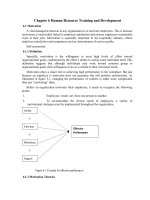Employee training and development 5th chapter 08
Bạn đang xem bản rút gọn của tài liệu. Xem và tải ngay bản đầy đủ của tài liệu tại đây (535.75 KB, 50 trang )
Chapter 8
E-Learning and Use of Technology in
Training
McGraw-Hill/Irwin
Copyright © 2010 by the McGraw-Hill Companies, Inc. All rights reserved.
Technology’s Influence on
Training and Learning
New technologies have made it possible
to:
reduce the costs associated with delivering
training.
increase the effectiveness of the learning
environment.
help training contribute to business goals.
8-2
Technology’s Influence on
Training and Learning (cont.)
New training delivery and instructional
methods include:
online learning (e-learning)
distance learning
simulations
virtual reality
expert systems
electronic support systems
learning management systems
8-3
Technology’s Influence on
Training and Learning (cont.)
Benefits of Technology
Employees can gain control over when and
where they receive training.
Employees can access knowledge and expert
systems on an as-needed basis.
The learning environment can look, feel, and
sound just like the work environment.
Employees can choose the type of media they
want to use in a training program.
8-4
Technology’s Influence on
Training and Learning (cont.)
Benefits of Technology
Paperwork and time needed for administrative
activities is reduced.
Employees’ accomplishments during training
can be monitored.
Traditional training methods can be delivered
to trainees rather than requiring them to
come to a central training location.
8-5
Technology’s Influence on
Training and Learning (cont.)
Digital collaboration
use of technology to enhance and extend
employees’ abilities to work together
regardless of their geographic proximity.
can be synchronous or asynchronous.
8-6
Technology’s Influence on
Training and Learning (cont.)
Prior to the introduction of new
technology:
Trainees played a passive role in learning.
Interaction among learners occurred primarily
outside the training room and tended to be
limited.
Due to technology, learning has become
a more dynamic process.
Instructor is more of a coach and resource
person.
8-7
Figure 8.1 - Types of Learning
Environments
8-8
Figure 8.1 - Types of Learning
Environments
8-9
Figure 8.1 - Types of Learning
Environments
8-10
Technology and Multimedia
Multimedia training - combines
audiovisual training methods with
computer-based training.
8-11
Table 8.2 - Advantages and
Disadvantages of Multimedia Training
8-12
Computer-Based Training
It is an interactive training experience in
which:
the computer provides the learning stimulus.
the trainee must respond.
the computer analyzes the responses and
provides feedback to the trainee.
It includes interactive video, CD-ROM, and
online learning.
CD-ROMs and DVDs utilize a laser to read
text, graphics, audio, and video off an
aluminum disk.
8-13
Computer-Based Training (cont.)
Interactive video - instruction is provided
one-on-one to trainees via a monitor
connected to a keyboard.
Online learning, or e-learning - instruction
and delivery of training by computer online
through the Internet or the Web.
Internet-based or Web-based, training - training
delivered on public or private computer networks
and displayed by a Web browser.
Intranet-based training - training that uses the
company’s own computer network; accessible only
to the company’s employees.
8-14
Figure 8.3 - Potential Features of
E-Learning
8-15
Table 8.3 - Advantages of ELearning
8-16
Table 8.4 - Research Results Regarding
the Effectiveness of Online Learning
8-17
Table 8.5 - Factors Limiting the
Use of E-Learning
8-18
Table 8.6 - Tips for Developing
Effective Online Learning
8-19
Table 8.6 - Tips for Developing
Effective Online Learning
8-20
Table 8.7 - Principles for
Designing E-Learning
8-21
Computer-Based Training (cont.)
Technology for collaboration and linking
Bandwidth - number of bytes and bits
(information) that can travel between
computers per second.
Online learning should try to build in
interactivity without requiring the use of
plug-ins - additional software that needs to
be loaded on the computer to listen to sound
or watch video.
8-22
Computer-Based Training (cont.)
Technology for collaboration and linking
Hyperlinks - links that allow a trainee to
access other Web sites that include printed
materials as well as communications links to
experts, trainers, and other learners.
Learning portals – Web sites or online
learning centers that provide, via e-commerce
transactions, access to training courses,
services, and online learning communities
from many sources.
8-23
Table 8.8 - Common Ways of
Collaboration in Online Learning
8-24
Blended Learning
It combines online learning, face-to-face
instruction, and other methods for
distributing learning content and
instruction.
In comparison to classroom delivery,
blended learning:
provides increased learner control.
allows for self-directedness.
requires learners to take more responsibility
for their learning.
8-25









